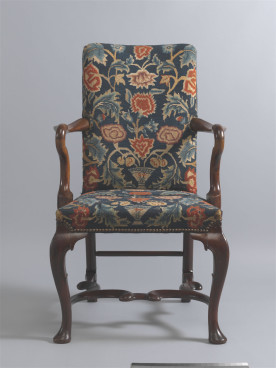Armchair, c.1725–35
Walnut with possibly original needlework
This chair was formerly in the collection of Percival D. Griffiths (1862–1937).
Adam Bowett Catalogue (19/08/2012)
Description
An armchair, circa 1725-35. The rectangular back and trapezoid seat are covered with close-nailed floral woollen needlework. The back is closed with blue/grey woolen cloth. The ‘shepherd’s crook’ arms are on back-curving supports. The seat is raised on cabriole forelegs with raised corners, and on turned back legs joined by a scrolling H stretcher.
Dimensions
H: 38 ½” (98cm) Seat height: 18” (46cm) W: 22 ¾” (58cm) D: 24” (61cm)
Materials
Walnut, beech, mahogany, softwood, lacewood (Platanus spp.)
Dating criteria
‘Shepherd’s crook’ arms are usually though to be an early feature. The raised corners to the forelegs occur on a number of well documented sets of chairs dating from the 1720s, and this is consistent with the elaborate style of the stretcher, also datable to the 1720s.
Construction
Construction of the back is conjectural because fully enclosed by upholstery. The seat rails are tenoned into the tops of all four legs. There are softwood braces nailed across both front corners which are further reinforced by shaped mahogany blocks screwed into the corners. The back seat rail is reinforced by a lacewood rail which rests alongside it and is housed at each end into the side rails. The back stretcher is dowelled into the back legs. The H stretcher is made in three parts; the two side pieces are tenoned into front and back legs; the medial stretcher is tenoned into the side stretchers and secured with pegs. The arms are made in two parts, the lower part is lapped over and probably tenoned into the seat rail (sometimes called a tongued tenon joint), the upper part is probably screwed to the back frame. The upper and lower parts of the arms are joined with a mortise and tenon.
Condition
There is a repair to the front of the right arm where the mortise has broken out; both right and left arm joints have slips of wood inserted to take up slack and there is worm damage to the lower ends of both arms. Joints between medial and side stretcher have been repaired and re-pegged. The back seat rail is probably not original, nor is the lacewood reinforcing batten. Corner braces and corner blocks not original. The outside brackets on both front legs have been spliced and repaired. Front left bracket possibly not original. All the pegs at the tops of the forelegs are replaced.
References
W. Symonds, English Furniture from Charles II to George II, London (1929), p.150, fig. 98.
R.W. Symonds, ‘Chairs and Stools in the Collection of Mr. J.S. Sykes’, Apollo Magazine (August 1937), p. 26, fig vi.
For examples of chairs with extended corners at the tops of the legs see Adam Bowett, Early Georgian Furniture 1715-1740, Woodbridge (2009), Chapter 4. For comparable stretcher designs see Lucy Wood, Upholstered Furniture in the Lady Lever Art Gallery, 2 Vols. New Haven and London (2008), I, Nos. 15 & 16.
Provenance
Percival D. Griffiths
J. S. Sykes














